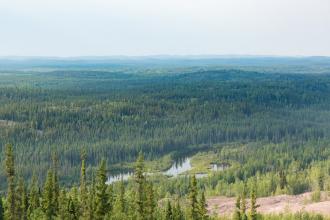Blog Post: ADAPTATION IN THE CANADIAN BOREAL FOREST

PLANNING FOR CLIMATE CHANGE ADAPTATION IN THE CANADIAN BOREAL FOREST
There are many potential impacts that climate change may have on Canada’s boreal forest. Changes in fire regimes, insect outbreaks, tree growth and tree species distributions will eventually result in a forest different from the one we see today. (Read more)
While some impacts of climate change may be prevented by reducing emissions, some degree of climate change will occur due to the carbon dioxide already in the atmosphere. Therefore, industry and government will need to prepare for a different forest environment, and develop strategies for dealing with the new conditions.
ADAPTING TO THE NEW FOREST
These strategies are called adaptation, i.e. adapting to the new forest in a way that still allows us to receive the benefits from the forest on a sustainable basis. This applies to all users of the forest: Indigenous communities, recreationists, forest companies and others.
Over the past 10 years, a group of provincial, territorial and federal forestry practitioners, including SRC, has developed a suite of tools and guidance for forest managers to assist them in understanding their vulnerability to climate change.
Forest managers are the primary decision makers for forest companies and decide, for example, when to harvest, when to plant seedlings and where roads will be located. The tools also help them to identify adaptation strategies that will enable them to continue to practice Sustainable Forest Management into the future.
Sustainable Forest Management (SFM) is the Canadian approach to forest management, and is based on six criteria developed by the Canadian Council of Forest Ministers (CCFM):
- Biological Diversity
- Ecosystem Condition and Productivity
- Soil and Water
- Role in Global Ecological Cycles (e.g. the global carbon cycle)
- Economic and Social Benefits
- Society’s Responsibility (Indigenous treaty rights, community well-being, etc.)
This work was done under the auspices of the CCFM and funded by the jurisdictions that make up the CCFM.
IDENTIFYING AND IMPLEMENTING ADAPTATION ACTIONS
The centrepiece of these tools is a guidebook for forest managers that walks them through a structured process for understanding their climate change vulnerability, and then guides them in identifying and implementing adaptation actions.
The vulnerability assessment includes developing information on climate change impacts, and assessing the organization’s capacity to implement adaptation (called their adaptive capacity).
Once their vulnerability is assessed, forest managers go on to identify adaptation options that can decrease the extent of impacts from climate change.
One suggested approach (there can be others) is to use the CCFM’s six criteria mentioned earlier.
For each of these criterion, vulnerability can be assessed and specific actions identified to reduce the vulnerability. For example:
- protecting habitat to maintain biodiversity
- planning drought-resistant nursery stock to maintain ecosystem productivity
- reviewing road standards (e.g., culvert size) to reduce the chance of flooding and road washouts due to extreme rain events
MAINSTREAMING CLIMATE CHANGE THINKING
An essential aspect of this approach is the concept of mainstreaming. This refers to incorporating climate change thinking into day-to-day planning and decision making rather than treating it as a separate issue to be considered in addition to everything else.
Experience has shown that an ideal vehicle for mainstreaming climate change into Sustainable Forest Management is the 20-year forest management plan required by many Canadian jurisdictions. As these planning exercises proceed, the forest company and its public advisory group are thinking strategically, and planning ahead for how their operations will be carried out.
This is ideal for thinking about climate change impacts, and how to adapt so that Sustainable Forest Management can continue into the future.
Category:

































